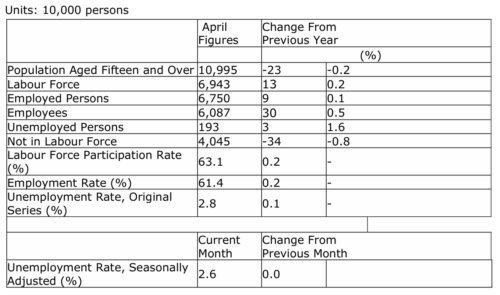Economic and Labour Situation in Japan, June 2024
2024 Spring Struggle for a Better Life: Wage Increase Exceeds the Inflation Rate of the Previous Year
On June 5, RENGO (Japanese Trade Union Confederation) carried out its sixth tally of wage hike settlements reached in the 2024 Spring Struggle for a Better Life. RENGO’s tally revealed that 4938 unions that had demanded average wage hikes for members and engaged in labour–management negotiations had reached settlements by that time.
The average wage hike in these settlements (including the regular wage hike) was 15,236 yen, the equivalent of 5.08% of the average wage before the hike: more than at the same stage last year at 4,429 yen and 1.42 percentage points.
At unions with more than 1000 members, the average wage hike was 16,211 yen, up 5.19%: more than at the same stage last year at 4,692 yen and 1.46 percentage points.
Of unions with fewer than 300 members, the average wage hike was 11,361 yen, up 4.45%: more than at the same stage last year at 3,033 yen and 1.09 percentage points, and reaching the highest level since 1992 compared to final tallies of the past.
As an evaluation of RENGO, the following statement can be made: In the spring labour struggle of 2024, RENGO made the highest commitment to wage increases since 2014, with the highest wage increase including regular raises since 1991, reaching the 5% range.
The wage increase exceeded the inflation rate of the previous year. Both labour and management recognize that this is a crucial moment for eliminating the deflationary mindset and achieving a stage transition in our country’s economic and social spheres.
Considering the impact on household budgets due to high prices and the increased burden on the front lines due to labour shortages, negotiations were persistent and sincere with a long-term perspective on the importance of “investment in people” that leads to the growth of industries, companies, and ultimately the Japanese economy. This result can be described as achieved by actively creating significant momentum. It is recognized as a major step towards stage transition.
Labour Force Survey Monthly Results*1
(1) Employment
The number of employed persons in April 2024 was 67.50 million, an increase of 90,000 over the same month the previous year. By gender, this included 36.88 million men, down 10,000, and 30.62 million women, up 10,000 over the previous year.
(2) Unemployment
The number of unemployed persons in April 2024 was 1.93 million, an increase of 30,000 from the same month in the previous year.
The seasonally adjusted unemployment rate in April was 2.6%, unchanged from the previous month. The unemployment rate for men was 2.8%, up 0.1 points over previous month, and for women 2.4%, down 0.2 points from the previous month.

(3) Job Availability
Japan’s job availability in April stood at 1.26, down 0.02 points from the previous month, marking the first drop in two months, as high material prices weighed on recruitment in the manufacturing sector. This ratio means there were 126 job openings for every 100 job seekers.
The ratio of regular employee job offers to applicants was 1.02, down 0.01 points from the previous month.
The ratio of new job offers to applicants, a leading indicator for the labour market, was 2.17, down 0.21 points from the previous month. The number of new job offers decreased 2.3%. By industry, lifestyle and entertainment services rose 3.4%. The manufacturing sector fell 7.8%, while education dropped 7.4%.
Industrial Production*2
Industrial output in April decreased 0.1% from the previous month, weighed down by a decrease in production of airplane parts as well as cars amid a Toyota Motor Corp. worldwide recall. Production, inventories and inventory ratio decreased, while shipment increased. The industries that mainly contributed to this decrease were as follows: (1) transport equipment (excl. motor vehicles); (2) general-purpose and business oriented machinery; and (3) electrical machinery, and information and communication electronics equipment, in that order.
According to the Survey of Production Forecasts in Manufacturing, production was expected to increase 6.9% in May and decrease 5.6% in June.

Family Income and Expenditure Survey*3
(1) Expenditure of Households of Two Persons or More
Average monthly consumption expenditure of households of two or more persons in April was 313,300 yen, up 3.4% in nominal terms and up 0.5% in real terms over the previous year, for the first increase in 14 months, lifted by increased outlays on education and clothing amid warmer temperatures.
(2) Income and Expenditures for Workers’ Households
Average monthly income per household stood at 566,457 yen, up 2.3% in nominal terms but down 0.6% in real terms from the previous year, due to higher inflation rates. The average level of consumption expenditure was 345,020 yen per month, up 3.2% in nominal terms and up 0.3% in real terms year-on-year.
Consumer Prices*4
The consumer price index (CPI) in April was 107.7 (2020 = 100), up 2.5% over the previous year and up 0.2% over the previous month. Core inflation (CPI less food and energy) was up 2.4% over the previous year and unchanged from the previous month. Energy prices increased 0.1%, led by kerosene and gasoline, but electricity and city gas prices fell due to government subsidies to reduce utility bills. Food prices (excluding volatile fresh items) rose 3.5%, though the gain moderated from 4.6% in March. Accommodation fees jumped up 18.8%, as travel demand continued to recover with the return of foreign tourists to Japan.

1. Source: Labour Force Survey Monthly Results (Statistics Bureau of Japan)
https://www.stat.go.jp/english/data/roudou/results/month/index.html
2. Source: Indices of Industrial Production (Ministry of Economy, Trade and Industry)
https://www.meti.go.jp/english/statistics/tyo/iip/index.html
3. Source: Summary of the Latest Month on Family Income and Expenditure Survey (Statistics Bureau of Japan)
https://www.stat.go.jp/english/data/kakei/156.html
4. Source: Consumer Price Index (Statistics Bureau of Japan)
https://www.stat.go.jp/english/data/cpi/1581-z.html
https://www.stat.go.jp/english/data/cpi/1581-z.html
https://www.stat.go.jp/english/data/cpi/1581-z.html
